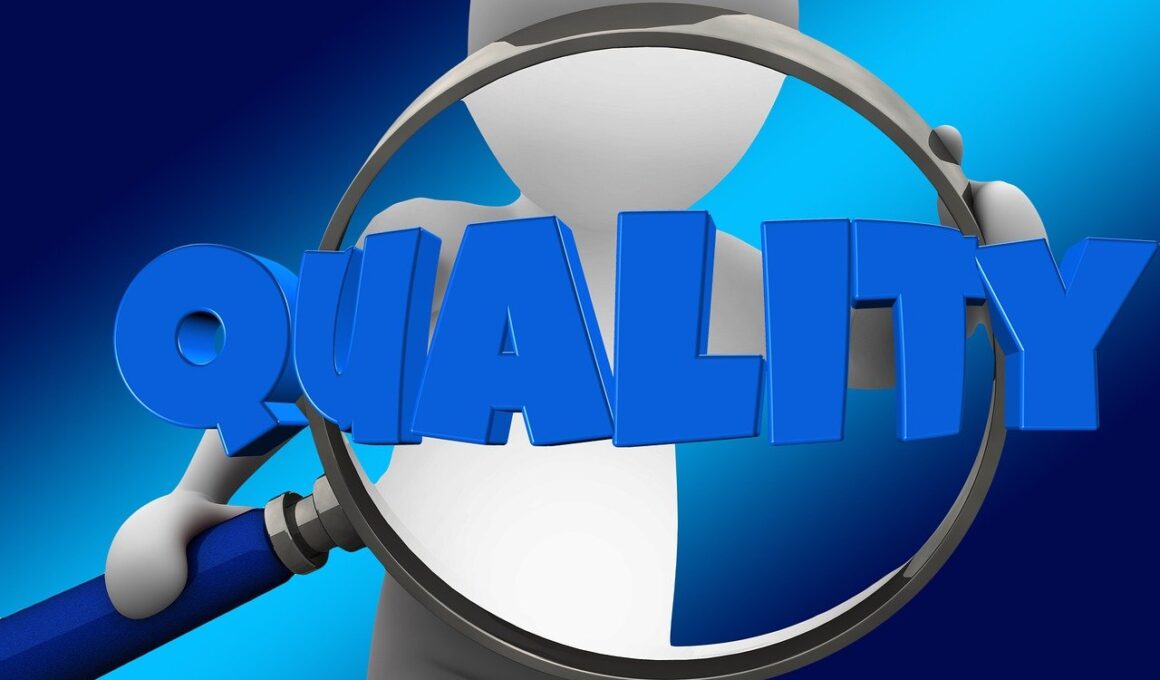The Importance of Transparency in Sustainability Certifications
Transparency plays a vital role in sustainability certifications, ensuring trust among stakeholders. It allows consumers to understand the processes behind certification, fostering informed choices. Essential for brands, transparency distinguishes credible certifications from greenwashing. By implementing rigorous auditing processes and public reporting, organizations can demonstrate their commitment. Transparency also facilitates better communication between companies and stakeholders, enhancing accountability. Certifications that lack clarity may lead to skepticism among consumers who are increasingly concerned about sustainability issues. Companies must strive for open communication, ensuring that their practices are easily accessible. This openness encourages consumers to engage with sustainability goals, thus supporting responsible brands. Furthermore, as regulations tighten globally, transparency in sustainability should become standard practice. By revealing sourcing, production methods, and supply chain practices, companies can mitigate risks associated with misleading claims. Moreover, establishing a reputation based on transparency enables companies to build loyalty and trust. Organizations that embrace transparency often enjoy positive recognition in the marketplace, promoting their sustainability efforts effectively. Ultimately, by prioritizing transparency, businesses contribute to a more sustainable future while gaining competitive advantages in an increasingly concerned consumer landscape.
Furthermore, transparency in sustainability certifications also benefits the broader community. It allows non-governmental organizations (NGOs) and advocacy groups to validate claims made by companies. This validation is crucial in holding organizations accountable for their sustainability promises. The collaborative nature of these interactions can lead to improved sustainability practices. Transparent certifications can also facilitate benchmarking. Companies can compare their practices with industry standards, driving them to adopt best practices. As a result, this leads to continuous improvement in their sustainability performance. Transparency thus promotes an ecosystem where companies not only compete but also work towards common sustainability goals. Stakeholders, including consumers, employees, and investors, demand clarity on how sustainable claims are being validated. Research indicates that certified companies often see increased revenues due to consumer support for ethical practices. This correlation encourages firms to commit to transparency as they realize the financial benefits associated. Additionally, consumers tend to choose products from brands that demonstrate a genuine commitment to sustainable practices. Consequently, transparency is not just a nice-to-have feature; it is becoming an essential component of business strategy in sustainability certifications. Companies unable to adapt may face reputational or financial repercussions in the future.
Impact of Transparency on Consumer Trust
Consumer trust in sustainability certifications is increasingly influenced by transparency. When companies openly share their sustainability measures, consumers are more likely to view their certification as credible. Clear information about how sustainability claims are verified allows consumers to make informed choices. This, in turn, promotes loyalty to brands that embody transparent practices. A trust deficit can arise if manufacturers keep details hidden, leading to skepticism regarding their motives. Transparency bridges this gap, helping companies establish direct relationships with consumers. As awareness of environmental issues grows, consumers seek brands aligned with their values. Transparent sustainability certifications cater to this demand, emphasizing the significance of credibility in marketing. Access to information about sustainability practices contributes positively to company image. It empowers consumers to advocate for brands they trust, thus increasing word-of-mouth referrals. Research shows that consumers are more inclined to pay a premium for products from transparent brands. Consequently, transparency is not just ethical; it is also economically favorable for businesses. In addition, consumers often engage in discussions about their purchasing choices. This engagement can lead to a community of conscious consumers who advocate for transparency and accountability in sustainability certifications.
Moreover, transparency can enhance innovation within organizations aiming for sustainability certifications. By being transparent about their practices, companies invite feedback from stakeholders, including customers and experts. This feedback loop can lead to innovative solutions that improve sustainability outcomes. For instance, organizations may discover better methods for reducing waste or improving energy efficiency through open dialogue. Transparency can also facilitate collaboration across industries, as companies learn from each other’s successes and challenges. In environments where transparency is prioritized, knowledge sharing becomes standard. This collaboration may lead to the development of new technologies, certifications, or best practices that can be adopted industry-wide. Furthermore, regulators are becoming increasingly aware of the need for transparency in sustainability. They may impose stricter requirements for certifications, prompting companies to proactively seek higher standards. By aligning with transparent practices, firms can stay ahead of regulatory changes, minimizing compliance risks. Companies that embrace transparency not only improve their sustainability ratings but also bolster their reputations. This proactive approach can be a significant asset in industries facing intense scrutiny regarding their environmental impacts. Ultimately, transparency fosters an organizational culture of continuous improvement toward sustainability goals.
Building a Transparent Certification System
To establish a successful transparent certification system, multiple key factors must be considered. First, clarity in communication materials is essential. Companies should ensure that certification criteria and processes are straightforward and understandable. Utilizing language that is accessible to the general public helps demystify complex standards. Second, third-party verification of sustainability claims is crucial. Engaging independent auditors can enhance credibility and strengthen public trust in certifications. This step ensures that claims are accurately represented and can withstand scrutiny from consumer advocacy groups. Third, organizations should invest in technology that tracks and reports sustainability metrics over time. Implementing systems for ongoing monitoring can help maintain transparency in certifications. Next, fostering stakeholder involvement is vital for feedback collection, as it allows companies to gauge public opinion. By incorporating stakeholder insights, organizations can adapt and improve their practices accordingly. Finally, consistency and continuity in certification practices are necessary. Companies should align their strategies with evolving sustainability trends and societal expectations to remain relevant. Overall, fostering a transparent certification system involves collaboration, continuous evaluation, and commitment to sustainable practices, ultimately leading to success in sustainability outcomes.
Additionally, the role of technology in enhancing transparency in sustainability certifications cannot be understated. Technologies such as blockchain can facilitate secure and traceable supply chains. By leveraging blockchain, all transactions and sustainability claims can be recorded and made accessible to stakeholders. This level of transparency helps mitigate the risks associated with fraud and greenwashing. Moreover, digital platforms can serve as a means for companies to share real-time updates on their sustainability initiatives. Such platforms not only foster transparency but also engage consumers in meaningful dialogue. Social media can amplify these efforts, offering companies a dynamic way to communicate their sustainability achievements. Furthermore, mobile applications can provide consumers with instant access to crucial information regarding certifications. By providing detailed info about product origins, production processes, and sustainability claims, companies build trust with consumers who prioritize ethical choices. In addition, utilizing data analytics enables companies to assess their sustainability performance and monitor improvements. Both internal and external data sharing can drive accountability and transparency in sustainability certifications. The integration of technology is vital for advancing transparency throughout the sustainability landscape.
Conclusion: The Path Forward
In conclusion, fostering transparency in sustainability certifications is crucial for future success. Companies that prioritize clear communication, independent verification, and stakeholder involvement will ultimately blossom. A commitment to sustainability riddled with transparency helps organizations authenticate their claims genuinely. As consumers become increasingly knowledgeable, the demand for transparency will only rise, paving the way for changes in the market. Companies must also recognize the competitive advantages clarity can bring, such as enhanced consumer loyalty and trust. Furthermore, the collaborative spirit fostered through transparency can drive innovations that elevate entire industries. Moving forward, embracing transparency should not be seen as a burden; rather, it is an opportunity to engage stakeholders in a meaningful way. By sharing successes and challenges transparently, organizations can build a strong foundation for continuous improvement in sustainability efforts. Additionally, regulatory frameworks will continue to evolve, pushing companies to adopt transparent practices to comply with new standards. By taking proactive steps toward transparency, organizations will not only contribute to a sustainable future but will also secure their reputation as leaders in ethical practices in finance.
In the long term, this approach will positively impact businesses, consumers, and the environment alike. By integrating transparency into sustainability certifications, we can better align economic goals with ecological values. A transparent approach encourages responsible sourcing and production methods that ultimately benefit all stakeholders. As sustainability becomes a central tenet of corporate strategy, companies must prepare to embrace transparency as a vital component of their ethics. Establishing a culture of transparency will charge the brand identity while enriching the consumer experience. This change can motivate organizations to become proactive rather than reactive concerning sustainability issues. Therefore, organizations should initiate conversations around transparency with all stakeholders consistently. Engaging in dialogues not only enhances accountability but promotes a culture of honesty and openness. Each effort to be transparent can lead to new opportunities and partnerships that focus on sustainability. Consumers increasingly appreciate brands that demonstrate authenticity in their practices. In an era where misinformation can easily spread, organizations focusing on transparency are better equipped to build lasting relationships. The path forward lies in transparency; companies willing to adapt will find success in an evolving financial landscape that values sustainability-centered practices. Embracing this change benefits everyone and ultimately shapes a brighter future.


